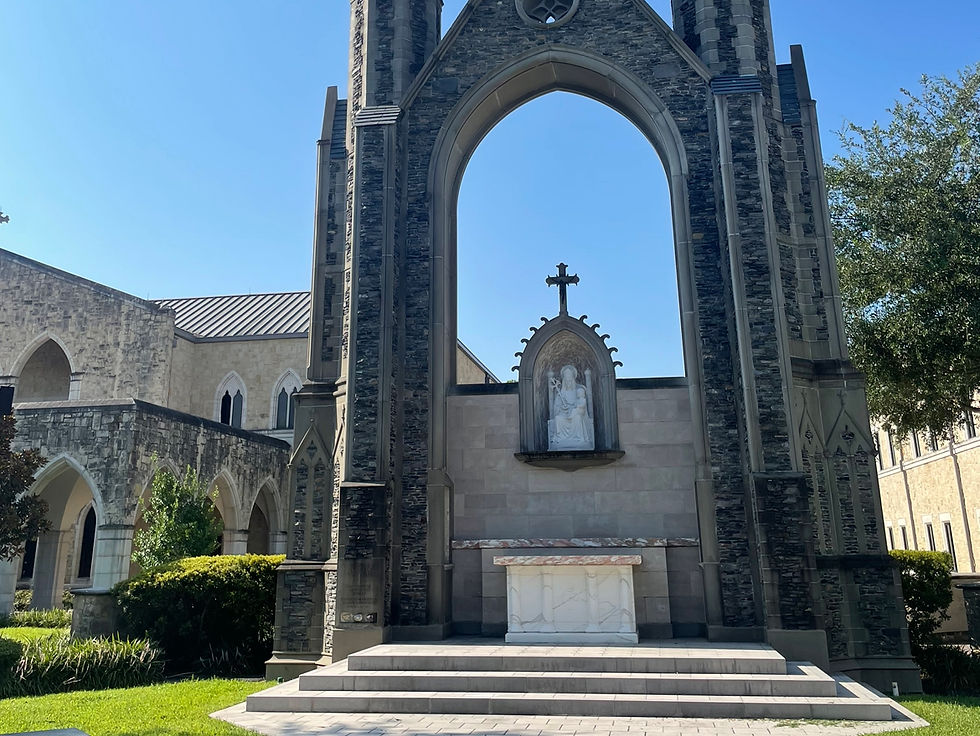Luna duodécima
- Kelvin Sandigo
- Mar 3, 2023
- 4 min read
Updated: Sep 23, 2023
One of the spiritual practices my family engaged in during the previous Advent season was the recitation of Compline. We were assisted in this beautiful ora by the seminarians at St. Thomas Aquinas. Though we've waxed and waned in our recitation of that Hour since then, it has engendered in us admiration, fascination and jubilation for the Divine Office. I have since sought ways to incorporate the Office in a practical way amidst my daily duties and have settled on regularly praying the sister Hour to Compline, Prime, at the start of the day.
I thankfully do not have to reinvent the wheel as the coders at Divinum Officium have provided an indispensable foundation for 21st-century traditionalists. But I wanted to chant Prime as I had Compline, and this has led to several of months of adventure in reading through the Liber Antiphonarius, mining a chant repository and learning a new software language. The simple and predictable nature of Prime helped to keep me from being discouraged in this endeavor, as even the other Little Hours changed frequently following the Proper of the Saints, but the hardest nut for me to crack was the incorporation of the Roman Martyrology at the end of Prime.
Finally acknowledging that the accounts being read are for the saints commemorated the following day (as their vigils would occur on the evening the text is being read), I still had trouble figuring our what was going on with the alphanumeric table at the heading of each day. As it turns out, days of both the solar and the lunar calendars are recognized. The former is denoted in the Roman fashion referencing the Kalends, Nones or Ides (not just days to be assassinated), and the latter by a number between one and thirty. The steps to get this number are to determine the Golden Number of the year, find the corresponding Epact and then find the corresponding Martyrology Letter which will be used all year long. It definitely is complicated, but not unnecessarily so since this practice, revised in the Gregorian reforms of 1583, has been essential in determining the date of Easter since the First Council of Nicea in 325.
To simplify the process expounded here, 2023 is divided by 19, leaving a reminder of 9 which gets augmented by one to give the Golden Number 10 which corresponds to an Epact of viii and a Martyrology Letter of h. All this so that before I read of the heroic acts of blessed Casimir et al. I can chant...

...and so that I can look up at tonight's sky and see the moon on its twelfth day.
I admit that this exposition may not be entriguing enough to have one take up praying Prime and the Martyrology; for that I have future posts on the Breviary and the saints in mind. But I felt this worth sharing because, in the vein of my first essay, I am in awe at the lengths that the Church, especially since Trent, has labored to establish the stability of Its Liturgy into perpetuity.
I'll leave with this anecdote. Throughout the year, the Martyrology is usually chanted in either of two simple tones, Lectionem Matutini or Recto. But on the morning of December 24th, the liturgical books allow for the Birth of Our Lord to be announced with grand flourish. Between the Modus Ordinarius and the Modus Solemnior (pages 1 and 3, respectively, here), it's obvious which is the more popular. And so on Christmas Eve, we can hear...
In the 5199th year of the creation of the world, from the time when God in the beginning created the heaven and the earth; the 2957th year after the flood...
-J. B. O’Connell, 1962 translation of the 1958 edition of the Martyrologium Romanum
After Sacrosanctum Concilium suppressed the Hour of Prime in ¶ 89 § d, this practice unsurprisingly fell into disuse. In the 1980's JPII revived it at his Christmas celebrations, but it wouldn't be until the 2001 edition of the Martyrology (a story for another day) that you'd likely encounter it at the neighborhood parish, belted out by Susan in her mother tongue. Now said before the midnight service (usurping the tradition of chanting Christmas Matins), it is rendered thusly...
When ages beyond number had run their course from the creation of the world, when God in the beginning created heaven and earth, and formed man in his own likeness; when century upon century had passed since the Almighty set his bow in the clouds after the Great Flood, as a sign of covenant and peace...
Living with the reality of the august Canon being papered over with an Italian café napkin, prelates boasting of composing a counter-Syllabus and those making arguments for creating a throne for the Lord with their hands (while conspicuously omitting the admonition to also hallow their eyes and other sense organs), this not the most shocking of innovations. But it just goes to show how few stones were left unturned in the ressourcemont, and how many need to be reclaimed in the Restoration.








Comments